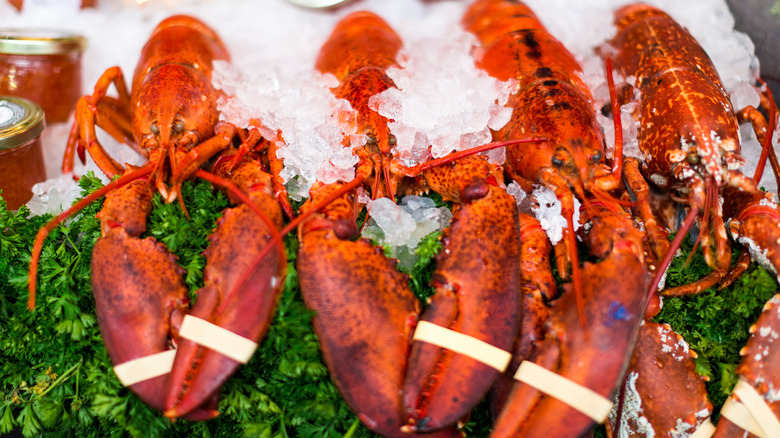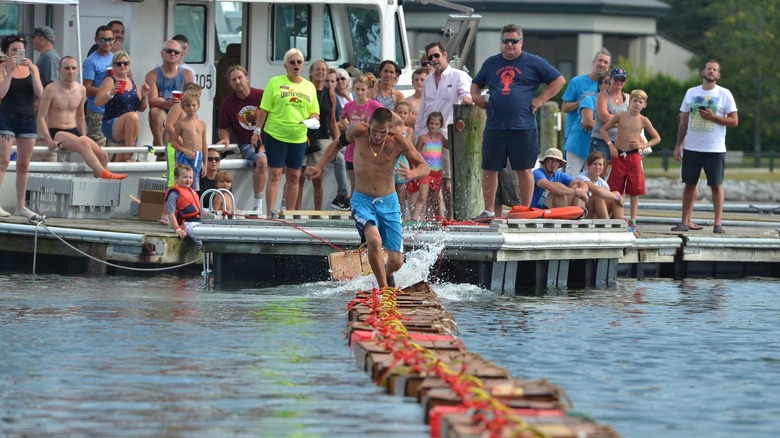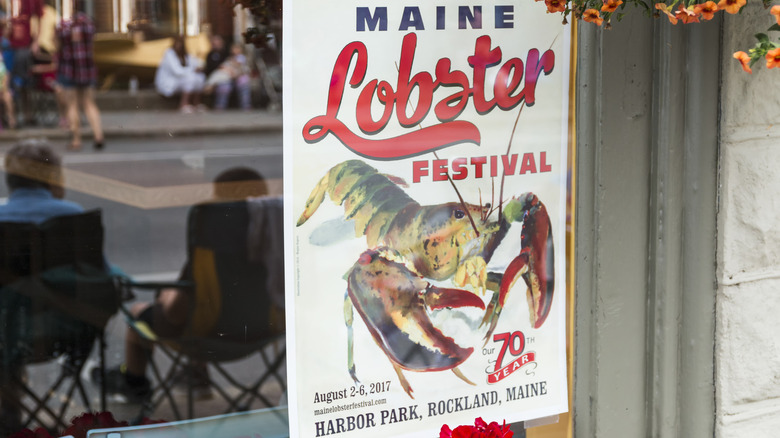Maine Lobster Festival's International Great Crate Race Is A Sight To Behold
Maine lobster is one of the most alluring meals you can find on a menu. There is perhaps no place on Earth more famous for its lobsters than the East Coast state, a fact highlighted every year during the first weekend of August when seafood lovers from near and far flock to the Maine Lobster Festival.
Founded in 1947, the event is a true crustacean bonanza featuring a parade, live music, and, of course, a gobsmacking amount of lobster meat. You can sample dishes that range from traditional lobster rolls to more novel lobster-stuffed risotto balls. But this is not just a weekend of celebration; it is also one of fierce competition.
The Maine Lobster Festival (held in the town of Rockland) features a slew of contests, pitting lobster lovers against one another in some truly unique events. There's a seafood cooking contest with a grand prize of $525 on the line, as well as 5K and 10K races, a children's lobster eating contest, a "diaper derby" for babies, and the Cod Fish Carry, in which children race each other while carrying 12-pound codfish.
However, none of these events can match the wonderful weirdness of the International Great Crate Race, in which contestants must run across a stringed chain of 50 floating lobster crates that stretch across the Rockland Harbor. It's a test of speed, endurance, and, most of all, balance. Lose your footing, and you'll fall into the frigid water in front of hundreds of spectators.
This lobster crate race has unique rules
The International Great Crate Race was started in the 1970s by William Atwood, a third-generation lobsterman and founder of the Atwood Lobster Company. Originally held at the company's headquarters in nearby Spruce Head, the competition became so popular that it was soon incorporated into the larger Maine Lobster Festival, and has now become one of its signature events. Instead of racing to a finish line, contestants are measured by endurance. They must run across all 50 chained lobster crates, and when they reach the other side, they have to turn around and do it all over again. Contestants run back and forth as many times as they can until they either fall into the water or become too tired to continue. Winners are ranked according to the total number of crates they step on before dropping out.
The crate race has four divisions: featherweight (contestants up to 75 pounds), lightweight (entrants weighing 76-125 pounds), medium weight (126-175 pounds), and heavyweight (more than 176 pounds). The heavier you are, the more likely you are to topple over, which is why children typically perform best in the event (not to mention their increased levels of energy). The race record was set in 2014 by two competitors — Scarlett Flint (age 7) and Harrison Page (age 9) — who each totaled an astounding 6,500 crates before the race was called off due to nightfall.
How to participate in the International Great Crate Race
Do you think you have what it takes to survive the International Great Crate Race? If you're planning to head to the Maine Lobster Festival in August and want to take part in this one-of-a-kind event, here's what you'll need to do. Signups are held on the Sunday morning of the festival, and although registration officially begins at 7:00 a.m., the event is so popular that people typically start lining up at 5:00 a.m. Spots are limited, so it's best to be on the early side. There's a participation fee of $15 for contestants over the age of 11 and $10 for contestants 11 years of age and younger. The race itself begins at 2:00 p.m.
If you plan on participating, here are a few tips to help you out. You will need footwear, as bare feet will ensure you slip almost immediately. Sandals are not recommended, but a pair of water shoes would be a good idea. You must accept that you will almost certainly fall into the water eventually, and know that it's going to be cold when you do.
According to the National Weather Service, the average water temperature for that part of Maine in the month of August hovers around 60 degrees Fahrenheit. Race organizers stay close by in boats, so when you fall, you can get a ride back to shore. Lastly, just embrace the fall. It is inevitable, so make it fun. And if you can pull off some acrobatics, you'll get a big round of applause from the audience any way.


